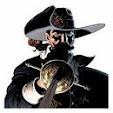Versión en español
Everyone is familiar with Daniel Defoe's novel Robinson Crusoe, which is based on the experiences of a real character. Many know what the Manila Galleon was. Probably fewer have heard of the sailor Juan Fernández. In this short article we link the three stories.
Juan Fernández (c.1528/1530 - 1599) was a sailor born in Cartagena famous for having found a sea route that allowed the trip between El Callao (Peru) and Valparaíso (Chile) in a fraction of the time previously taken.
For years, the ships skirted the coast by sailing south against what is nowadays called the Humboldt stream. Completing the trip required three or more months. Juan Fernández had much experience in this so slow and difficult navigation and decided to make a detour away from the coast. Thus he avoided the sea current and the trip time was reduced to only 30 days.
Between 1563 and 1574, Juan Fernández also discovered the islands of St. Felix and St. Ambrosio and the archipelago that today bears his name.
The Juan Fernández archipelago is located more than 600 km off the coast of Chile and consists of two main islands, Más Afuera (Farther Away) and Más a Tierra (Closer to Land), and several islets (see Note 1).
In 1703, during the War of Spanish Succession (1701-1713), the English privateer and explorer William Dampier organized with the approval of the Admiralty an expedition to the Pacific to attack Spanish traffic there.
The second mate of one of the ships of this expedition, the Cinque Ports, was a privateer Scotsman named Alexander Selkirk (1676 -1721). The expedition was not a success and the captain of the Cinque Ports separated from Dampier.
In 1704, the Cinque Ports stopped at the uninhabited island of Más Afuera to replenish water supplies. Due to differences with his captain on the condition of the ship (which actually sank soon after), Alexander Selkirk was abandoned on the island, where he spent four years and four months.
Daniel Defoe's novel The Life and Adventures of Robinson Crusoe, published in 1719 is based on the experiences and the character of Alexander Selkirk.
Selkirk's rescue came in 1709 when another English privateer fleet made landfall on the island of Más Afuera for getting supplies and recovering from scurvy. It consisted of two ships, the Duke, led by the leader of the expedition Woodes Rogers, being William Dampier the pilot, and the Duchess.
Rogers named to Selkirk as Duke’s second and later on as captain of a captured Spanish ship, but that was soon returned after paying a ransom.
The expedition continued sailing north. At the height of the Baja California coast, near Cape San Lucas, after lurking for two months, on 1 or 2 January 1710 (see Note 2), they captured one of the most coveted preys all over the seas, a Manila galleon, the Nuestra Señora de la Encarnación y Desengaño (see Note 3). It was a brief fight, but Rogers took a bullet to the jaw what disfigured him. Many of the crew and passengers of the Spanish galleon were liberated on the Californian coast.
A few days later, they located and got ready to capture also the Nuestra Señora de Begoña, the second galleon that was doing the Manila-Acapulco route that year. But the Begoña fought bravely and the Duke and the Duchess were damaged. They had to retire and the galleon continued her journey to Acapulco.
Once Rogers' ships were repaired, and with Selkirk as pilot of the captured galleon, they sailed for Guam island, where they entered under a white flag and were well received by the Spanish governor, who in any case had no means of defence. There they exchanged almost all the remaining Spanish and Filipino crew of the Nuestra Señora de la Encarnación y Desengaño, renamed Bachelor, for supplies, especially food, water and firewood. They then continued on to Batavia, in present-day Indonesia, then under Dutch rule, where Woodes Rogers underwent surgery on his wound.
The Duke, the Duchess and the Bachelor returned to England by the route of the Cape of Good Hope. Selkirk was the pilot of the Duke. They reached the destination in October 1711 thus completing their circumnavigation.
 |
| Galleon Andalucía (2010) |
Notes
(1) On January 1, 1966, in order to attract tourism, Chilean President Eduardo Frei renamed Robinson Crusoe to the Más a Tierra Island, and Alexander Selkirk to the Mas Afuera Island.
(2) The date, 1 or 2 January 1710, varies according to the source. Moreover, as the English had not yet adopted the Gregorian calendar (Britain and its colonies did so in September 1752), their historiography refers to 22 December 1709.
(3) The Manila Galleon (or ship from China, or Acapulco galleon, or Silk ship) linked Filipinas to Acapulco between 1565 and 1815. It was an amazing feat of navigation having great economic and cultural impact. In its 250 years of existence, despite continuous attempts by its enemies, only 4 galleons were captured, all of them by the British, during the wars between Spain and Britain:
- Cavendish captured the Santa Ana in 1587.
- Woodes Rogers the Encarnación in 1710.
- George Anson the Covadonga in 1743.
- Samuel Cornish, actually two of his ships, the Santísima Trinidad in 1762.
Bibliography and links
El galeón de Manila. William Lytle Schurz. Ediciones de Cultura Hispánica. Madrid 1992. English original edition: New York 1939
Juan Fernández. Wikipedia (English)
Juan Fernández. Wikipedia (Spanish)
Juan Fernández Islands. Wikipedia (English)
Archipiélago Juan Fernández. Wikipedia (Spanish)
Alexander Selkirk. Wikipedia (English)
Alejandro Selkirk. Wikipedia (Spanish)
Woodes Rogers. Wikipedia (English)
Woodes Rogers. Wikipedia (Spanish)








%20hundi%C3%A9ndose.jpg)


No hay comentarios:
Publicar un comentario